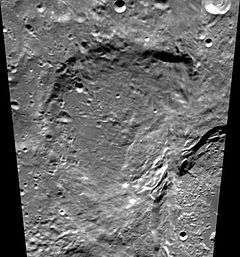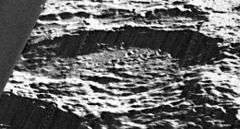Minnaert (crater)
Minnaert is a large lunar impact crater that is located on the far side of the Moon, deep in the southern hemisphere. It is partly overlain along the southeastern side by the larger and younger crater Antoniadi. To the west-northwest lies Lyman.
 Clementine mosaic | |
| Coordinates | 67.8°S 179.6°E |
|---|---|
| Diameter | 125 km (78 mi) |
| Depth | Unknown |
| Colongitude | 185° at sunrise |
| Eponym | Marcel Minnaert |

Nearly half the crater is overlain by the rim, outer rampart, and ejecta from Antoniadi. The remaining rim is worn and eroded, with a number of small craterlets along the edge and inner wall. The western interior floor is relatively level, but is marked by ejecta and secondary cratering from Antoniadi. If the crater ever possessed a central ridge, it may now be buried.
Satellite craters
By convention these features are identified on lunar maps by placing the letter on the side of the crater midpoint that is closest to Minnaert.
| Minnaert | Latitude | Longitude | Diameter |
|---|---|---|---|
| C | 64.2° S | 176.0° W | 15 km (9.3 mi) |
| N | 71.1° S | 176.1° E | 33 km (21 mi) |
| W | 63.4° S | 174.1° E | 24 km (15 mi) |
References
- Andersson, L. E.; Whitaker, E. A. (1982). NASA Catalogue of Lunar Nomenclature. NASA RP-1097.CS1 maint: ref=harv (link)
- Blue, Jennifer (July 25, 2007). "Gazetteer of Planetary Nomenclature". USGS. Retrieved 2007-08-05.CS1 maint: ref=harv (link)
- Bussey, B.; Spudis, P. (2004). The Clementine Atlas of the Moon. New York: Cambridge University Press. ISBN 978-0-521-81528-4.CS1 maint: ref=harv (link)
- Cocks, Elijah E.; Cocks, Josiah C. (1995). Who's Who on the Moon: A Biographical Dictionary of Lunar Nomenclature. Tudor Publishers. ISBN 978-0-936389-27-1.CS1 maint: ref=harv (link)
- McDowell, Jonathan (July 15, 2007). "Lunar Nomenclature". Jonathan's Space Report. Retrieved 2007-10-24.CS1 maint: ref=harv (link)
- Menzel, D. H.; Minnaert, M.; Levin, B.; Dollfus, A.; Bell, B. (1971). "Report on Lunar Nomenclature by the Working Group of Commission 17 of the IAU". Space Science Reviews. 12 (2): 136–186. Bibcode:1971SSRv...12..136M. doi:10.1007/BF00171763.CS1 maint: ref=harv (link)
- Moore, Patrick (2001). On the Moon. Sterling Publishing Co. ISBN 978-0-304-35469-6.CS1 maint: ref=harv (link)
- Price, Fred W. (1988). The Moon Observer's Handbook. Cambridge University Press. ISBN 978-0-521-33500-3.CS1 maint: ref=harv (link)
- Rükl, Antonín (1990). Atlas of the Moon. Kalmbach Books. ISBN 978-0-913135-17-4.CS1 maint: ref=harv (link)
- Webb, Rev. T. W. (1962). Celestial Objects for Common Telescopes (6th revised ed.). Dover. ISBN 978-0-486-20917-3.CS1 maint: ref=harv (link)
- Whitaker, Ewen A. (1999). Mapping and Naming the Moon. Cambridge University Press. ISBN 978-0-521-62248-6.CS1 maint: ref=harv (link)
- Wlasuk, Peter T. (2000). Observing the Moon. Springer. ISBN 978-1-85233-193-1.CS1 maint: ref=harv (link)